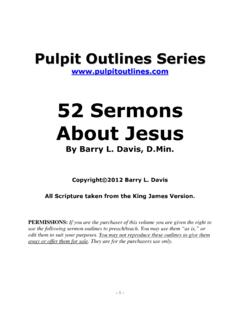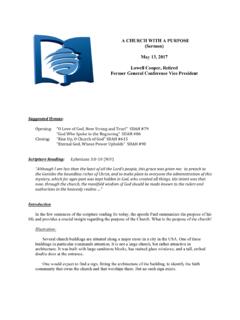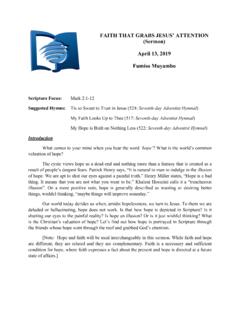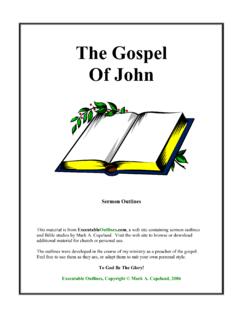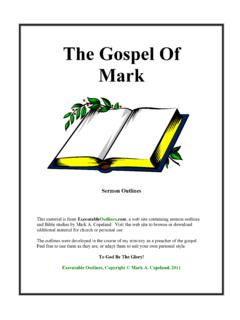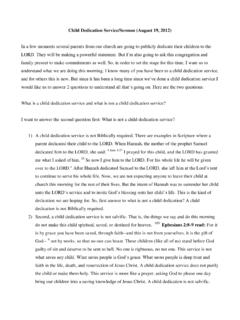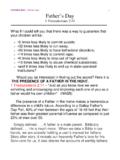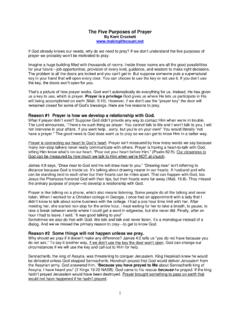Transcription of Proclaiming Life in Death: The Funeral Sermon
1 Proclaiming life in death : The Funeral Sermon Donald L. Deffner A young pastor went home for lunch to find his wife raped and strangled, his two toddlers left unharmed. "Mommic's sleeping upstairs, Daddy," they told him. "A man came to the house." Later the gricving father appeared on television, saying that hc had forgiven his wife's murderer and asking othcrs to find it in their hearts to do so too. The Funeral service was characterized by a sense of the victory of Easter. The bulletin stated the following: The bIack border around this paper is not only for thc memory of Sharon or for the grief of her loved ones, but for a sick humanity. All of us have felt in these days some- thing of the terrible misery of what it means to be human. For a short time the mask was stripped away, and we caught a glimpse of the hell in human hearts-the hell of love- lessness, of hatred, of callousness to other people, of our ready willingness to consume each other.
2 But it is precisely at this point-at graveside-that Chris- tianity, if it is to have any meaning at all, must begin to make sense. For it was to the very depths of this tragic human existence that God came personally in jesus Christ. And it was here that He redeemed us and our existence.. The mercy is this, that we who have faced our humanity in all its horror are now enabled through Christ to realize our humanity in all its glory, the glory of love. There was a qui tc different Funeral service which took place some fifty years ago. As a Lutheran left the Funeral service of her father, she overheard a Methodist friend say: "What a Sermon ! All about sin and death ! That man must have been a great sinner!" The man being buricd had, in fact, been a devout and loving Christian.
3 The exact religious background of his daughter's friends-and what they actually heard at that Funeral -cannot be ascertained at this point in time. In any case, however, this episode and the episode recounted before it indicate the crucial nature of what people hear, especially Concordia Theological Quarterly 58 (1994) no. 1 CONCORDIA THEOLOGICAL QUARTERLY non-Lutherans, when they come to a Funeral service. What is involved here? Many of the readers of this article will have preached hundreds more Funeral sermons than its author. The goal here, however, is to focus on what constitutes a biblical Funeral Sermon while simultaneously directing readers to various resources.' The author is particularly indebted to the insights provided by Robert G. Hughes in A Trumpet in Darkness: Preaching to ~ourners.
4 ' I. The Sermon in General First of all, a Funeral Sermon is the announcement of the Good News that jesus Christ has conquered death and the grave for us. It is biblical preaching that focuses on Calvary and the empty tomb, so that the mourners may deal with the reality of death and have the certain hope which God gives us for life now and the life to come in heaven. A Funeral Sermon therefore is basic and integral to the whole liturgy for the burial of the dead. Also, as Hughes suggests, "mourners may be emotionally ready, open to God's word in a way that secure individuals are not."3 Defenses are down, life is disrupted, and there is a need to restore balance to life . "It has been the experience of clergy that greater vulnerability leads to heightened receptivity more often than to stubborn defensiveness.
5 "4 Yet there must be a balance in what is preached in the Sermon -a balance between reference to the individual which is realistic (especially if the family knows the person far better than the pastor) and, on the other hand, delivering a Sermon with a "to whom it may concern" flavor. The preacher is certainly to personalize the Sermon , but without lauding the dead.' "A Christian Funeral Sermon is for the living, not the dead." Pastors have heard that principle stated many times. Accordingly, how can the sensitive pastor take into account exactly where the mourners are in their process of grief? "If a death has been sudden and tragic, with the anesthetic of shock working its protective magic, one aim of the Sermon may be to assist listeners to face death and begin to grie~e."~ On the other hand, when a person has lingered a long time before death , there may be a feeling of relief.
6 In either case, people may feel guilt. How does one preach to the particular feelings and questions of the sorrowing? The Funeral Sermon 7 The Funeral Sermon is a key factor in a continuing pastoral relationship which the pastor has with the famil y-hopefully . Accordingly, even as the pastor interprets the biblical text selected very carefully, so he must study the listeners as well. He is an "active li~tener."~ He must ask, "What is the mourners' sto- ry?"-that is, "What are their feelings and questions?" 11. The Hearers of the Sermon A. Phases of Mourning In his Worship and Pastoral Care William H. Willimon entitled one of his chapters "Liturgy and life 's Crises: The Funeral . " There he speaks of three "rites of passage" through which people go at the death of a loved one.
7 These three phases (quoting Van Gennep) are separation, transition, and reincorp~ration.~ I. Separation Willimon says he remembers a widow who asked him to go with her for a final look at her husband's body before the Funeral . He was hesitant, knowing it could be a disturbing experience for her. But after she had touched her husband's cheek tenderly, she said: "He's cold. You can shut it now." She had proceeded through the separation from her husband. Willimon rightly states: "To avoid such separation is to postpone a necessary first step in the grief process and to run the risk of prolonging the pain of grief or dealing with grief in less productive ways."9 2. Transition A second phase is transition. One day a woman is married; the next day she is a widow. One day children have a father; the next day he is gone.
8 Normal activities are suspended. The mourners are moving into a new status in life . At this point the fmeral service has a very important educative function. "Here the church says in effect, 'When death comes, these are things that we belie~e.""~ "Blessed are the dead who die in the Lord from henceforth-yea, saith the Spirit-that they may rest from their labours; and their works do follow them" (Revelation 14:13). "Let not your heart be troubled, neither let it be afraid" (John 14:27). 8 CONCORDIA THEOLOGICAL QUARTERLY "So teach us to number our days, that we may apply our hearts unto wisdom" (Psalm 90: 12). Particularly helpful at this time is the sheer "ministry of presence" to those who mourn. The author remembers A. R. Kretzrnann saying that, when a parishioner of his was: about to die, he would cancel other appointments and just "be thcre" with the family.
9 Extensive conversation may not be necessary at tirncs and certainly not such inappropriate comments as "I know just how you feel." A pastor-friend of mine in Philadelphia says that, after his father died, one person after another stuck his head in his church-office door with comments of that nature until finally he was on the vcrge of vomiting. But then one friend came in and simply said, "I care." That assurance meant more to him than all the other comments. But presence is not enough during this transitional stage. Words must be spoken. And the Funeral Sermon can do that speaking. 3. Reincorporation The third phase is reincorporation. The mourners are now separated from their loved one, and the Christian community seeks to help them in the time of transition. But now their friends help reincorporate them into the mainstream of lifc again.
10 And the Funeral Sermon can point in that direction-of the continued love and support of the caring Christian community." 3. Types of death All these aspects of the mourners' stories-thcir Seelings and questions-are contextual as a pastor prepares the Funeral Sermon . What are they asking? What are they trying to understand? Robcrt G. Hughes is particularly helpful here as he considers the various types of death which occw and the specific problems which may arise in the mowers. I. Prolonged death For many people, Hughes says, in connection with dcath from cancer or another lingering illness, the "dynamics of chronic grief' are anger and depression. Families feel helpless. Maybe the doctor is blamed. Anger at God is also common. The long waiting period The Funeral Sermon 9 can also lead to depression.


